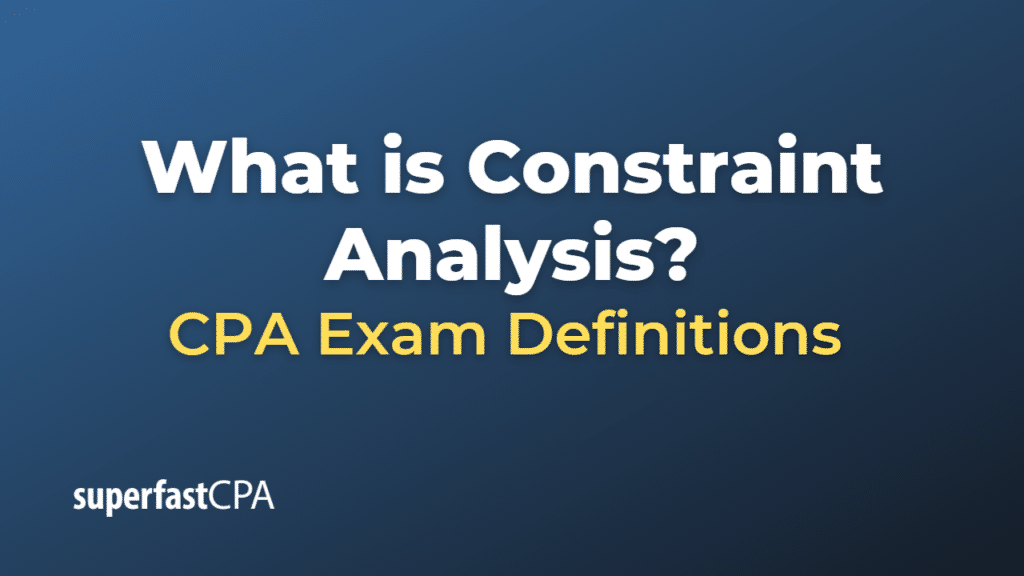Constraint Analysis
Constraint analysis is a systematic process of identifying, evaluating, and managing the constraints or limitations that affect the performance, efficiency, or effectiveness of a system, process, project, or organization. The main goal of constraint analysis is to improve decision-making, resource allocation, and goal achievement by understanding and addressing the factors that limit the system’s ability to achieve its objectives.
Constraint analysis typically involves the following steps:
- Identification: Determine the constraints or limitations that impact the system or process. These constraints can arise from various sources, such as physical, financial, legal, regulatory, technical, or human factors.
- Evaluation: Assess the nature and extent of each constraint, including its impact on the system’s performance, efficiency, or effectiveness. This may involve quantitative or qualitative analysis methods, depending on the nature of the constraint and the available data.
- Prioritization: Rank the constraints based on their relative importance, severity, or impact on the system’s performance, efficiency, or effectiveness. This helps to focus efforts and resources on the most critical constraints that need to be addressed.
- Management: Develop and implement strategies, actions, or interventions to address the identified constraints, either by eliminating, reducing, or mitigating their impact on the system’s performance, efficiency, or effectiveness. This may involve process improvement, resource reallocation, policy changes, or the use of new technologies or methods.
- Monitoring and review: Regularly monitor and review the progress and effectiveness of the implemented strategies, actions, or interventions to ensure that the constraints are being addressed effectively and to identify any new or emerging constraints that may require attention.
Constraint analysis can be applied to various fields, such as project management, operations management, strategic planning, and organizational development. By identifying, evaluating, and managing constraints effectively, organizations can improve their decision-making, resource allocation, and goal achievement, leading to increased performance, efficiency, and effectiveness.
Example of Constraint Analysis
Let’s consider an example from the field of manufacturing to illustrate the concept of constraint analysis:
Imagine you are the operations manager of a factory that produces electronic components. Your company’s management has set a goal to increase production output by 20% over the next year to meet growing demand. To achieve this goal, you conduct a constraint analysis to identify and address the factors limiting the factory’s production capacity.
- Identification: You identify the following constraints affecting the factory’s production capacity:a. Equipment: Some production machines are outdated and have limited capacity or frequent breakdowns. b. Labor: Skilled labor is in short supply, causing bottlenecks in specific production stages. c. Raw materials: The availability and timely delivery of certain raw materials are inconsistent. d. Space: The factory’s layout is not optimized, resulting in inefficient use of floor space and longer production times.
- Evaluation: You analyze the impact of each constraint on the production capacity and determine that the outdated equipment and labor shortages are the most significant constraints affecting the factory’s output.
- Prioritization: Based on your evaluation, you prioritize addressing the equipment and labor constraints as they have the highest impact on the factory’s production capacity.
- Management: You develop and implement strategies to address the identified constraints:a. Equipment: Invest in new, more efficient production machines to increase capacity and reduce downtime due to breakdowns. b. Labor: Implement training programs to improve the skills of existing workers and recruit additional skilled workers to alleviate labor shortages. c. Raw materials: Establish long-term contracts with reliable suppliers to ensure consistent availability and timely delivery of raw materials. d. Space: Optimize the factory layout and streamline production processes to maximize the use of available floor space and reduce production times.
- Monitoring and review: You regularly monitor and review the progress and effectiveness of the implemented strategies to ensure that the constraints are being addressed effectively. You also keep an eye out for any new or emerging constraints that may require attention.
By conducting a constraint analysis and addressing the identified constraints, you can significantly improve the factory’s production capacity, enabling the company to meet its goal of increasing output by 20% over the next year.













